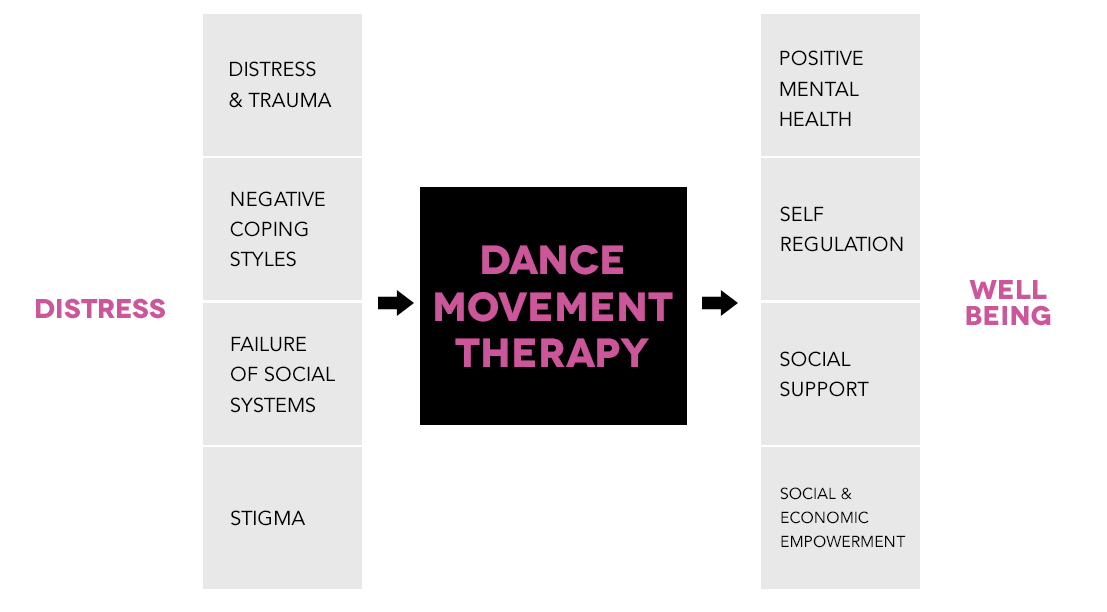Empowering Lives Through Dance Movement Therapy
DMT has been defined by the American Dance Therapy Association [ADTA] as “the psychotherapeutic use of movement to further the emotional, cognitive, physical and social integration of the individual” (www.adta.org, accessed 16th May, 2017).
It gives individuals the space to release trauma, express themselves creatively through movement, and free themselves in both body and mind.
It can be practiced both individually and in a group.
SAMPOORNATA
The Sampoornata model [meaning: fulfilment], was developed to heal and empower individuals from marginalised communities, including survivors of gender-based violence and at-risk children and youth.
A fundamental principle underlying the Sampoornata model is that survivors can become healers. DMT participants are given the opportunity to themselves evolve into DMT practitioners. In this way, they become agents of change in the community, creating an incredible cycle of transformation in society.
OUR CAUSES
One in three women worldwide face gender-based violence. Cycles of violence begin and end with the body, leading to adverse effects on the physical, emotional, social and cognitive well-being of survivors. They experience trauma, feelings of guilt, shame and self-loathing, along with the belief that there is no likelihood of a positive future. They are unable to access their agency, without which they are unable to empower themselves.
Childhood is characterised by the presence of risk and subsequent protective factors. This means that efforts at child protection have to expand to the prevention of risk and the promotion of effective rehabilitation, along with efforts to improve the experience of children within designated child protection institutions and systems.
Since our inception, Kolkata Sanved has been involved in the child protection system. Research has proven DMT plays a significant role in improving mental health outcomes and promoting well being. Research suggests that DMT and dance are effective for increasing quality of life and decreasing symptoms such as clinical depression and anxiety. Expressive methodologies have been shown to be more effective with children, compared to traditional dialogue therapy. The use of DMT within the child protection system has enabled many children to heal from trauma and reclaim their lives.

HOW DOES DMT HELP?
Dance Movement Therapy has a unique place in the rehabilitation process. It enables survivors to recover from trauma through the medium of the body. DMT participants are able to dismantle negative stigmas associated with their bodies following their trauma, and since body and mind are connected, they are able to foster a positive outlook towards the self and the future.
The DMT process results in empowerment. It enables survivors to access their agency, reenvision their future, and take steps towards achieving their aspirations.
HOW WE PROTECT CHILDREN
- Provision of immediate relief for stress and trauma. This is done through our healing and recovery program administered to children living in institutions
- Support survivors to develop skills and competencies to enable restoration
- Facilitate workshops with caregivers and staff in child care institutions to improve the experience of institutionalisation
- Creation of opportunities for livelihood. This enables children to lead autonomous lives after leaving the institutions at the age of 18. This is done primarily through our TOT program. While some are employed as dance movement therapy practitioners, others going through the program develop skills that enable access to better employment prospects
- Creation of a system of referrals for children in critical situations
OUR PARTICIPANTS
- Survivors of violence, exploitation and trafficking
- Children and youth living in:
- Government and NGO-run child care institutions
- Red Light Areas
- Railway Platforms
- Rural and urban slums
- School children
- People living with mental illnesses
- Children in conflict with the law
WHERE WE WORK
We are based in Kolkata. We have done extensive DMT sessions within the state of West Bengal, Maharastra, and various cities throughout India. We also conduct DMT sessions in Nepal, Thailand, and Bangladesh, and world wide.
